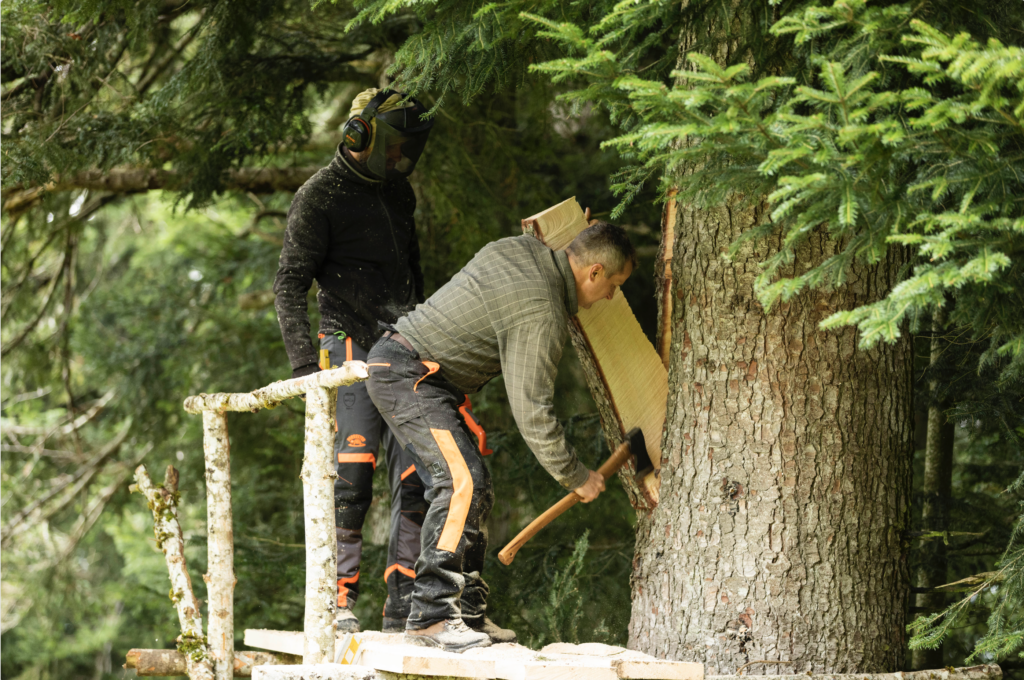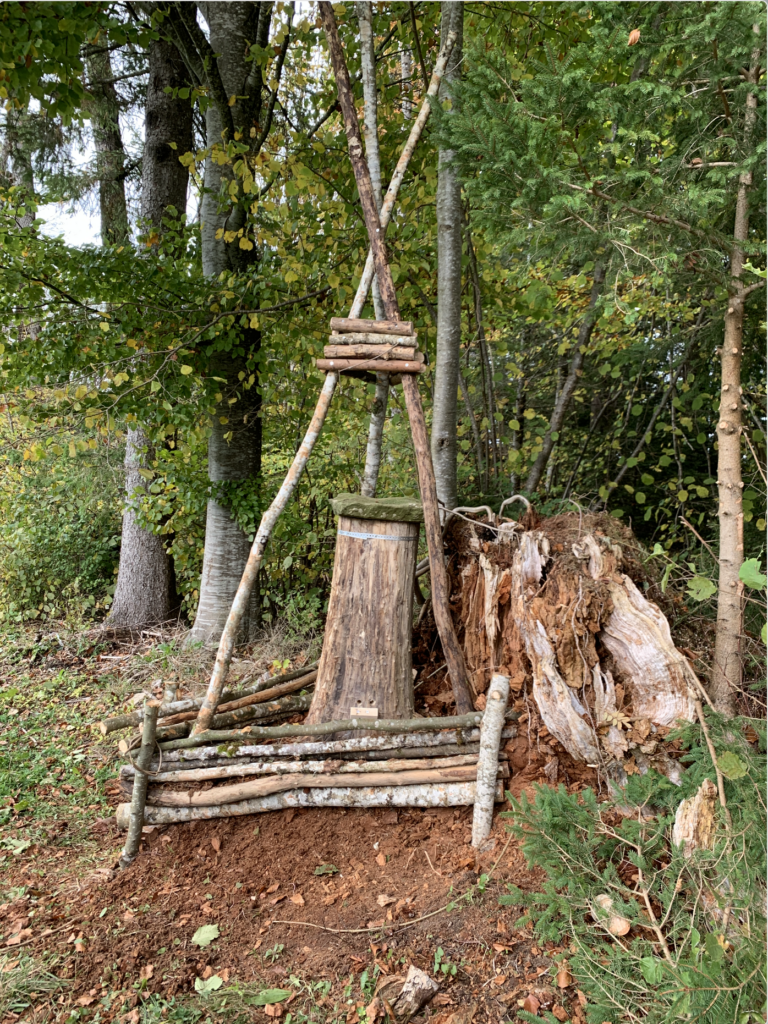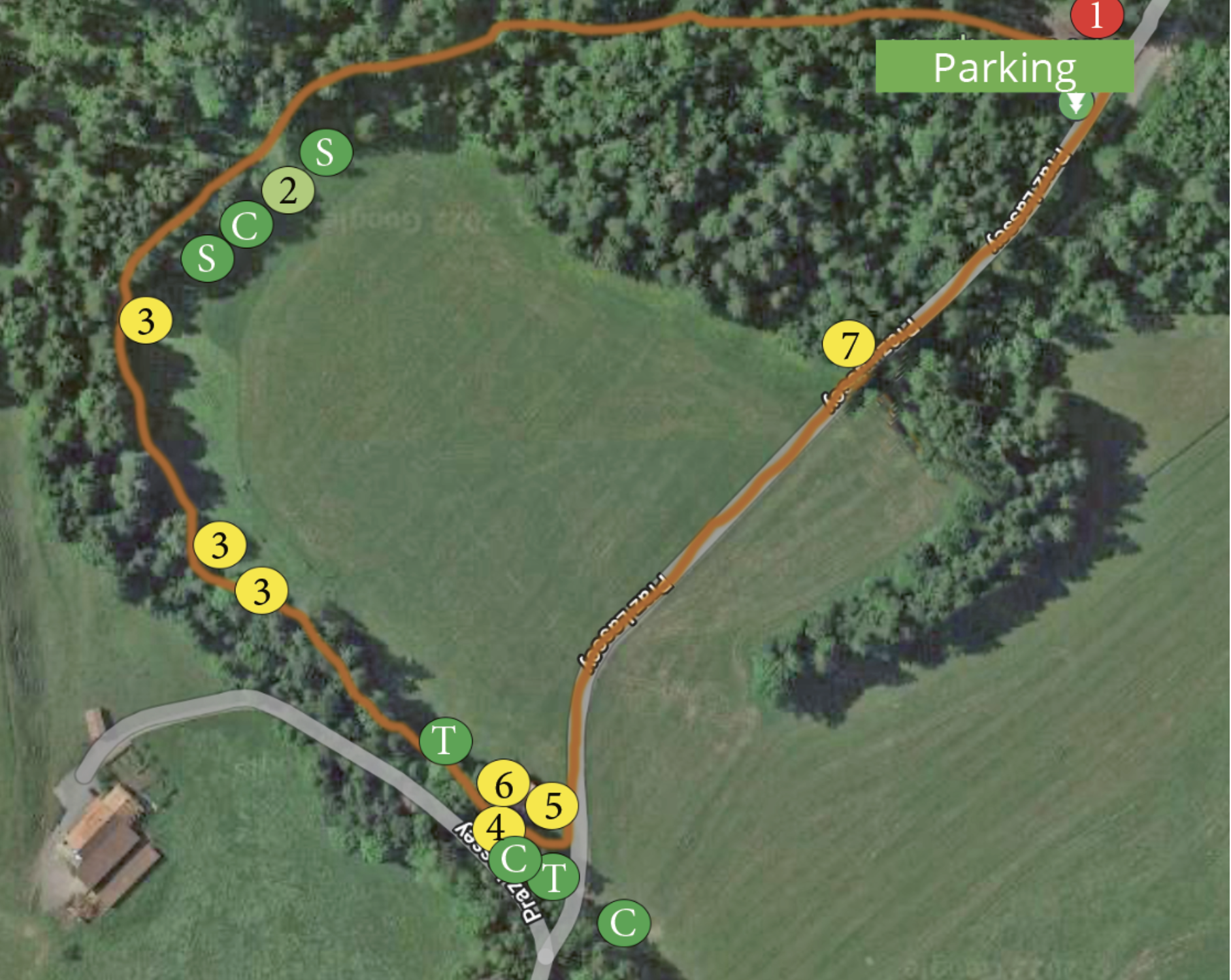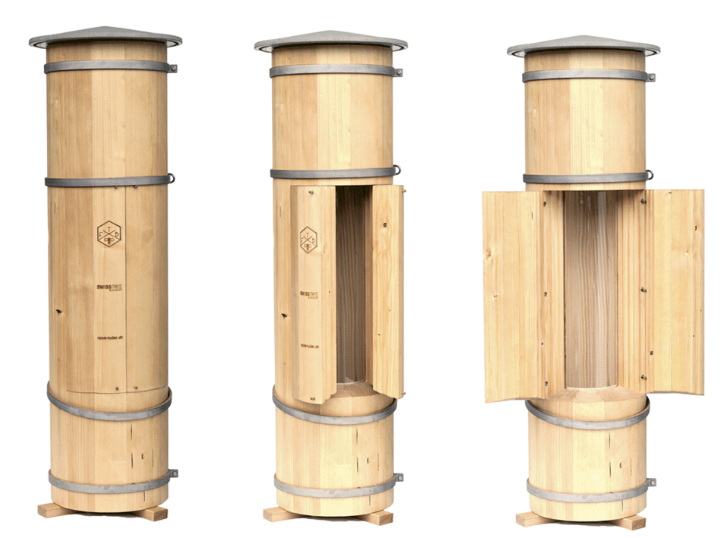Ecosocial discovery trail in Vaulruz FR
=> The trail has been open to the public since 1 October 2023
The honey bee, a forest insect to be rediscovered
FreeTheBees has carried out a number of projects for honeybees in 1627 Vaulruz FR – 3 cavities in living trees, 1 habitat for the bee and the scimitus, a predator of varroa mites, planting of honeybees, creation of a flower meadow and much more. – over the last 3 years. It is now time to show them off and make them available to the public.
Starting point
In the autumn of 2021, a course in Ancient Forest Beekeeping – originally called Zeidlerei – was organised under the responsibility of non profit organisation FreeTheBees.
Our general manager André Wermelinger, accompanied by 2 specialists, supervised some 15 trainees in the creation of: 3-cavity tree hives in living trees
It is very important for us to pass on this know-how through our Zeidler specialists. In our forests, old trees with natural cavities are becoming absolutely rare. The wild honey bee has little or no place to stay. One of the projects of FreeTheBees is to create or install 335 cavities or nesting boxes for not only bees, but also other dependent and interacting species or groups of species.

In the autumn of 2022, a second course was organised by our association: Varroa control: habitat construction course for Stratiolaelaps scimitus.
On the weekend of 22 and 23 October, 9 people came together to learn by doing how to create a habitat for the varroa mite Stratiolaelaps scimitus. It was pure adventure, being out in nature together, eating, spending the night, building and tinkering in the wind and cold.

Stratiolaelaps scimitus is a tiny (0.5 mm) predatory soil mite that colonises the first few centimetres of soil, living off small arthropods and/or mites – including varroa mites – or, in their absence, using plant residues and other organic debris. Its appetite and lifestyle have inspired some beekeepers to create a habitat for it under the hives.
The mite must be able to : –
live in an environment that suits it (compost or forest humus) and
– find an easily accessible food source.
The internship consisted of making different types of habitats to be integrated under any hive: Warré, and, of course, the SwissTree, the cavity simulations created by FreeTheBees.
It is one thing to house bees, but it is also important to create an environment that is conducive to their life in all seasons. To this end, trees have been planted in the meadow and a flower meadow has been created.
In our countries, intensive agriculture is making life difficult for our bees.
Indeed, apart from spring, with the flowering of fruit trees, an important source of nectar and pollen, the rest of the year can be difficult. Agriculture in May razes the countryside, the flowers disappear in a short time. In addition to the large quantities of manure spread, the lack of biodiversity, and for the bees, this “honey flow hole” is a catastrophe. This absence is synonymous with dearth, and therefore with mortality. The bee is a biological indicator for local nature.
It is therefore important to plant or sow melliferous species to fill these moments.
The property that will host this course is gradually becoming a place favourable to bees with the planting of trees such as lime, chestnut and soap trees. A forest garden is also being created.

The Project
The history of beekeeping is closely linked to the history of humanity. For thousands of years, honeybees have been kept by humans for their products such as wax and honey. Life in a beehive is fascinating: the complex social organisation should serve as an example for our lives, just as the health of a bee colony makes us aware of the intact local nature! Let’s allow as many people as possible, especially our children, to experience this fascination and introduce them to the inner world of bees. We want to raise awareness of the fact that the honey bee has almost disappeared from nature as an insect living without human intervention and that conventional beekeeping treats it intensively. Awareness of the natural processes in the hive is essential to identify real solutions to the disappearance of bees.
Observatory – Pavilion
This project aims to make the highly fascinating world of bees visible, palpable and perceptible to a wide audience.
For some time now, honeybees have been making regular headlines with sad messages. The death of bees has become a matter of concern for the general public.
But few people have ever had the opportunity to look inside a hive. Few people have seen a swarm of honeybees leaving, flying or stopping in a cluster, hanging from a branch. And hardly anyone has an objective and comprehensive view of the factors that lead to the death of bees.
A bee colony and its vitality immediately and directly indicate the state of the surrounding nature (plant diversity, environmental toxins, etc.). The comparison of the development of a bee colony raised in nature and a bee colony from conventional beekeeping shows us to what extent the beekeeper’s influences have an impact on nature. The awareness of the differences between untouched nature and human-influenced processes in a bee colony is the basis for possible improvements in the future.
Let’s allow as many people as possible, and especially our children, to absorb this fascination for bees and introduce them to the inner world of bees. Awareness of the natural processes in the hive is essential to identify real solutions to the disappearance of bees.
 The SwissTree Observer, one of the tree cavity simulations created by FreeTheBees, allows observation of the colony through a plexi.
The SwissTree Observer, one of the tree cavity simulations created by FreeTheBees, allows observation of the colony through a plexi.
The visitor opens the double door and can observe the bees working around the natural structure they have built. The bees themselves decide how the wax honeycomb is built. Only a minimal internal structure is provided to prevent any wax combs filled with honey from tearing.
Webcams allow observation of the interior and exterior of the hive and the display house. Inside the box, endoscopic cameras are used to film with light wavelengths that are invisible to the bees. This allows the bees to be observed in the darkness of the hive without disturbing factors. On the outside, the flight entrance is filmed on the one hand, and the entire observation pavilion on the other. The flight hole allows the direct flight to be seen, the camera, which is a little further away, allows the outgoing swarms or the mating flight to be observed. The cameras are all installed in such a way that no one (visitors, beekeepers, etc.) is inadvertently photographed (data protection).
A so-called hive scale electronically measures the weight of the hive and transmits the weight changes to a central server. This makes it possible to see how the bee colony is developing, including the crops (honey, pollen, etc.). If a swarm leaves, 2 kg of bees quickly leave the box in a few seconds/minutes. The scale notices this unusual weight loss and triggers an alarm. People who have registered in advance on the internet immediately receive an alert SMS and can watch exactly what is happening in the hive via the internet and the connected cameras.

